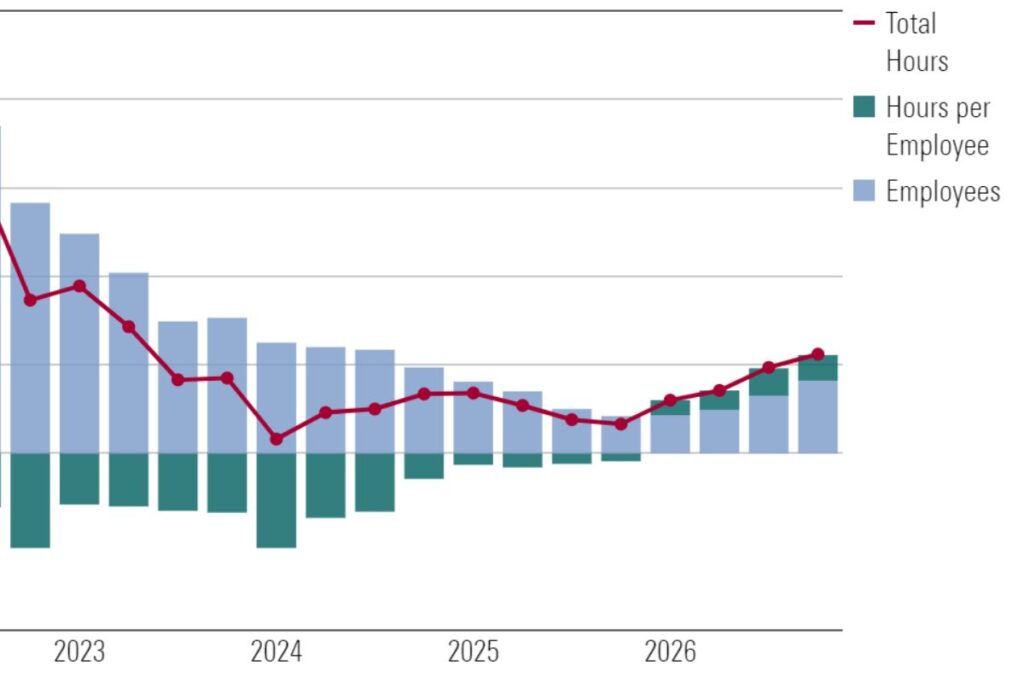The U.S. job market is showing signs of cooling as the latest employment report from the Bureau of Labor Statistics (BLS) reveals a modest addition of 151,000 jobs in February 2025. While this figure reflects continued growth, it falls short of the 170,000 jobs economists had anticipated, raising concerns among job seekers and industry experts alike.
With the unemployment rate ticking up to 4.1% and broader measures of labor underutilization climbing to 8%, the data paints a complex picture of a job market that’s losing momentum. For those hunting for work, the road ahead may be bumpier than expected.
Even before the release of Friday’s employment report, job seekers were feeling the strain of a tightening labor market. Now, with the numbers in hand, experts warn that the challenges are becoming more pronounced. From longer job searches to a shrinking workweek, the February 2025 employment report highlights trends that could reshape the U.S. economy and the tech industry in particular. In this article, we’ll break down the key findings, explore their implications, and offer insights into what this means for job seekers, employers, and the broader tech landscape.
February 2025 Employment Report: A Mixed Bag of Results
The BLS reported that the U.S. economy added 151,000 jobs in February 2025, a decent performance but one that fell below Wall Street’s expectations of 170,000 new positions. The unemployment rate edged up from 4% in January to 4.1% in February, signaling a slight softening in labor market conditions.
Read Also: 2025 Job Market Slowdown: Top Hiring Trends and Career Hacks to Beat the Odds
Meanwhile, a broader measure of unemployment—known as the U-6 rate, which includes people marginally attached to the workforce and those working part-time for economic reasons—jumped from 7.5% to 8%. This is the highest level since October 2021, a time when the economy was still reeling from pandemic-related job losses.
Cory Stahle, an economist at Indeed Hiring Lab, summed up the situation: “It remains uncomfortably difficult for unemployed people who want a job to quickly find one.” This sentiment is echoed by job seekers across industries, including tech, where competition for roles is intensifying. While the job market isn’t collapsing, the February employment report suggests that the robust growth of previous years may be giving way to a more cautious economic environment.
Key Trends in the U.S. Job Market: What the Data Reveals
The February 2025 employment report uncovers several trends that are raising eyebrows among economists and job market analysts. Let’s dive into the most significant findings and what they mean for the future.
A Slight Uptick in Unemployment
The unemployment rate’s increase to 4.1% may seem minor, but it’s a notable shift from the historically low levels seen in recent years. While 4.1% is still considered healthy by historical standards, the uptick reflects a growing number of people struggling to find work.
The broader U-6 rate’s climb to 8% is even more concerning, as it indicates that more individuals are underemployed or have given up on their job searches altogether. For tech professionals, this could mean heightened competition for roles in software development, cybersecurity, and data analysis—fields that have traditionally been in high demand.
Rising Part-Time Work for Economic Reasons

One of the most striking shifts in the February employment report is the increase in part-time work driven by economic necessity. Nearly 4.9 million people were working part-time “for economic reasons” last month, up from 4.4 million in January. This category includes individuals who want full-time work but can’t find it, as well as those whose hours have been cut due to reduced employer demand. The BLS notes that this uptick could reflect a softening labor market, where employers are scaling back hours rather than laying off workers outright.
In the tech sector, this trend could have significant implications. Companies like Google, Microsoft, and Amazon, which have historically offered stable full-time positions, may increasingly rely on part-time or contract workers to manage costs. For job seekers, this shift could mean fewer opportunities for stable, long-term employment and a greater reliance on gig or freelance work.
The Shrinking Workweek: A Recession Warning?
The average workweek remained steady at 34.1 hours in February, unchanged from January but slightly down from December 2024 and February 2024. While this might seem like a minor detail, it’s caught the attention of economists like Julia Pollak, chief economist at ZipRecruiter. “The 34.1-hour average is a level rarely seen outside of recessions,” Pollak observed. “That drop, combined with a rise in the number of workers forced into part-time jobs for economic reasons, suggests some employers are cutting back on hours rather than cutting jobs outright.”
A shrinking workweek can be an early indicator of economic trouble, as businesses often reduce hours before resorting to layoffs. In the tech industry, where companies like Tesla and Meta have faced pressure to streamline operations, a shorter workweek could signal cost-cutting measures that impact both employees and innovation. For tech workers, this trend might translate to fewer overtime opportunities and tighter budgets for projects requiring extended hours.
Longer Job Searches: A Growing Challenge
Another worrisome trend from the February employment report is the lengthening duration of job searches. The median time spent unemployed rose to 10 weeks in February 2025, up from nine weeks a year earlier. Additionally, the number of people experiencing long-term unemployment—defined as 27 weeks or more—has increased, according to the BLS. This suggests that finding a job is becoming a more protracted and challenging process for many Americans.
In the tech sector, where rapid hiring was once the norm, this trend could reflect a cooling demand for certain roles. While fields like artificial intelligence (AI) and cloud computing remain hot, other areas—such as traditional software engineering or IT support—may be seeing reduced hiring activity. For job seekers, this means more competition and a greater need to stand out with specialized skills or certifications.
Implications for the Tech Industry
The February 2025 employment report has significant implications for the tech industry, which has been a major driver of U.S. job growth in recent years. Here’s how these trends could affect tech companies, workers, and the broader economy.
A Shift Toward Cost Management

The rise in part-time work and the shrinking workweek suggest that employers, including tech giants, are focusing on cost management. Companies like Apple and IBM, which have historically invested heavily in full-time staff, may turn to more flexible hiring models, such as contract or part-time positions. This shift could reduce job security for tech workers and increase reliance on freelance platforms like Upwork or Fiverr.
For smaller tech startups, the cooling job market could exacerbate funding challenges. With venture capital investments already tightening, startups may struggle to attract talent without the promise of stable, full-time roles. This could slow innovation in emerging fields like quantum computing or blockchain technology.
Increased Competition for Tech Roles
As job searches lengthen and unemployment rises, competition for tech roles is likely to intensify. Fields that were once considered “safe bets”—such as software development or data science—may see an influx of applicants, making it harder for candidates to secure positions. Tech workers may need to upskill in high-demand areas like AI, machine learning, or cybersecurity to stay competitive.
For employers, this could be a double-edged sword. While a larger pool of candidates may make it easier to find talent, it could also increase the time and resources required to sift through applications and identify the best fits. Companies like Salesforce and Adobe, known for their rigorous hiring processes, may need to streamline recruitment to keep pace with demand.
Opportunities in High-Growth Sectors
Despite the challenges, the February employment report highlights opportunities in certain tech sectors. Healthcare, which added 52,000 jobs in February, is increasingly reliant on technology for innovations like telemedicine and electronic health records. Tech companies specializing in health tech—such as Teladoc Health or Epic Systems—could see a surge in demand for their services, creating new job opportunities for developers, data analysts, and IT professionals.
Similarly, the transportation and warehousing sector, which added 18,000 jobs, is leaning on technology to optimize logistics and supply chain management. Companies like Amazon, with its focus on robotics and automation, may continue to hire tech talent to support these efforts, even as the broader job market cools.
What This Means for Job Seekers
For job seekers, the February 2025 employment report is a wake-up call to adapt to a shifting labor market. Here are some practical steps to navigate the challenges:

- Upskill in High-Demand Areas: Focus on acquiring skills in growing fields like AI, cybersecurity, or cloud computing. Online platforms like Coursera, Udemy, and LinkedIn Learning offer affordable courses to help you stay competitive.
- Embrace Flexibility: Be open to part-time, contract, or freelance opportunities, especially if full-time roles are scarce. These positions can provide valuable experience and income while you search for a permanent job.
- Network Strategically: Leverage professional networks like LinkedIn to connect with recruiters and industry peers. Attend virtual or in-person tech events to expand your contacts and stay informed about job openings.
- Tailor Your Applications: With competition heating up, customize your resume and cover letter for each job application. Highlight relevant skills and experiences that align with the specific role and company.
The Broader Economic Context
The cooling job market reflected in the February 2025 employment report comes amid broader economic uncertainty. Factors like potential trade tariffs, federal government spending cuts, and shifting consumer confidence are creating headwinds for economic growth. Diane Swonk, chief economist at KPMG, noted that the rise in the U-6 unemployment rate to 8% signals a labor market that hasn’t fully recovered its pre-pandemic strength.
For the tech industry, which thrives on innovation and investment, these economic challenges could dampen growth prospects. However, the sector’s resilience—demonstrated by its ability to adapt to remote work and digital transformation during the pandemic—suggests that it may weather this slowdown better than other industries.
Read Also: Trump and Musk Ignite Federal Jobs: Career Surge Shakes Up 2025
Conclusion: Navigating a Cooling Job Market
The February 2025 employment report paints a picture of a U.S. job market that’s slowing but not stalling. With 151,000 jobs added, a 4.1% unemployment rate, and a shrinking workweek, the data suggests that job seekers, particularly in tech, will need to adapt to a more competitive and uncertain landscape. While challenges like longer job searches and increased part-time work are cause for concern, opportunities in high-growth sectors like health tech and logistics offer hope for those willing to pivot.
As the U.S. economy navigates this transition, the tech industry will play a critical role in driving innovation and job creation. What do you think about these trends? Are you feeling the impact of a cooling job market in your job search or workplace? Share your thoughts and experiences in the comments below—we’d love to hear from you!

